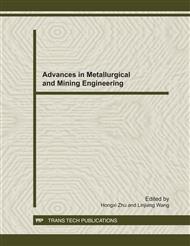p.142
p.147
p.151
p.156
p.160
p.165
p.169
p.173
p.179
Research on Thermal State of Mould Copper Plate with Different Heat Transfer Coefficient
Abstract:
Heat transfer coefficient has a great influence to the thermal state of the mould copper plate. The coupled visco-elasto-plastic FEM models have been presented for thermal process analysis of steel the mould copper plates. With the understanding to the mould thermal state for different heat transfer coefficient, the characters of mould copper plate thermal state is obtained. It is shown that, when the heat transfer coefficient increasing, the surface temperature of the mould plate would be lower, but the temperature distribution trend is steady, and at same time, the heat transfer coefficient has little influence to the equivalent strain distribution, especially for the nodes nearer to the meniscus. For breakout signal catching of this mould, the thermocouple is better to embedded lower than 300mm to the meniscus by vertical, and less than 30mm to the mould cold side by level.
Info:
Periodical:
Pages:
160-164
Citation:
Online since:
November 2011
Authors:
Price:
Сopyright:
© 2012 Trans Tech Publications Ltd. All Rights Reserved
Share:
Citation:


